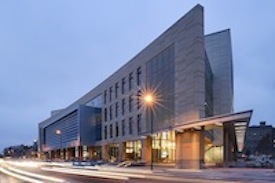Wisconsin Institutes for Discovery named 2012 Laboratory of the Year
The Wisconsin Institutes for Discovery, the innovative 330,000-square-foot public-private facility that opened just more than a year ago on the UW–Madison campus, has been named the 2012 Laboratory of the Year.

The Wisconsin Institutes for Discovery was named the 2012 Laboratory of the Year by R&D Magazine.
Photo: Jeff Miller
This international competition, sponsored annually by R&D Magazine since 1966, is judged by a panel of industry experts to recognize the highest standards in architecture, laboratory design and “push-the-envelope” concepts in science buildings.
The unique facility houses twin research institutes: the private, nonprofit Morgridge Institute for Research and UW–Madison’s public Wisconsin Institute for Discovery; and a main floor Town Center offering features and ongoing programming to engage the public in science. With architecture designed to encourage human interaction, the overarching goal of the building is to foster new interdisciplinary research collaborations across campus and beyond that lead to great discoveries in science.
“The award is a tremendous honor and reflects the careful collaboration, experience and skill that the project partners, donors John and Tashia Morgridge, the state of Wisconsin, UW–Madison and the Wisconsin Alumni Research Foundation used to plan, design and build this exceptional research facility, now recognized as such worldwide,” says George Austin, who served as the building project manager.
The Discovery building was built with three research floors aboveground and one below, and a public venue for science that spans its block-long main floor. The facility is located in the heart of campus at 330 N. Orchard St., between University Avenue and Campus Drive. In addition to flexible state-of-the-art laboratories, it includes civic spaces and a Mesozoic garden, meeting rooms, three public restaurants, and a university resource center for inventors, entrepreneurs and startup companies. The building earned LEED Gold certification last year.
The research floors are organized as laboratory “pods” with each designed to house up to five principal investigators and their teams. Two pods per floor are designated as wet laboratory space and a central pod shared by each floor’s occupants is focused on dry, computational operations.
Teaching laboratories, designed and outfitted exactly like the research labs, are located in pods on each of the three upper research floors and were built with separate, secure access from the research areas.
Large interior windows provide open views between the teaching labs, research areas and the Town Center below. The teaching labs are used with K-12 students and learners of all ages who take part in hands-on outreach programs, as well as with faculty and staff from across campus who attend workshops, equipment demonstrations and other events.
The facility was made possible due to the generosity of UW–Madison graduates John and Tashia Morgridge whose funding was matched by the state of Wisconsin and the Wisconsin Alumni Research Foundation (WARF), the private nonprofit patent and licensing organization for UW–Madison.
In this unusual public and private building partnership, WARF was appointed developer of the project. With research space split evenly between the public and private institutes, one-third of the facility is owned by the University of Wisconsin and two-thirds by WARF.
The winning project team, overseen by WARF Managing Director Carl Gulbrandsen, was led by project manager George Austin and key members of UW–Madison Facilities Planning and Management. The design and building team of the Wisconsin Institutes for Discovery included: Ballinger, the architect and lab planner; Uihlein Wilson, associate architect and interior designer; Affiliated Engineers, MEP engineer; Graef, Anhalt, Schloemer & Associates, civil and structural engineer; and Findorff|Mortenson, a joint venture for construction management.
A complete profile of the Wisconsin Institutes for Discovery will appear in the June 2012 issue of Laboratory Design newsletter, a publication of R&D Magazine. Project team members will receive awards and deliver a presentation on the project at the magazine’s 2012 Laboratory Design Conference in Pittsburgh on April 17.




